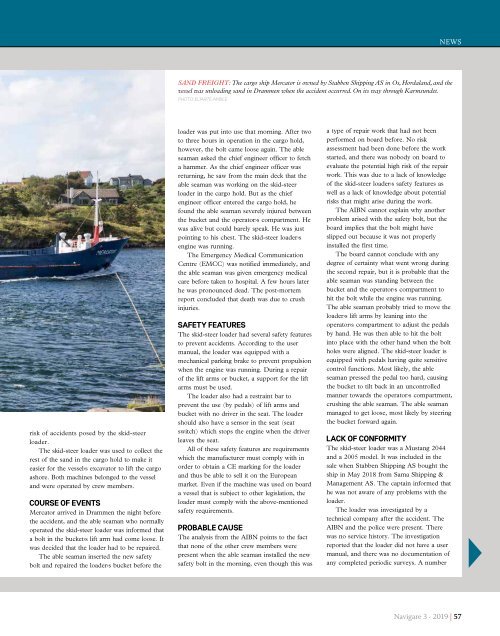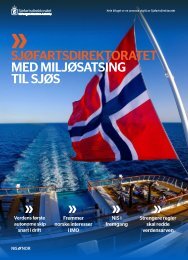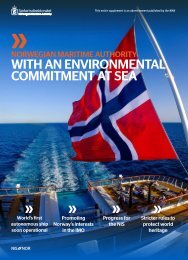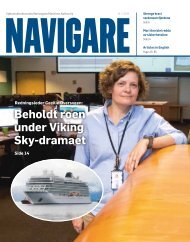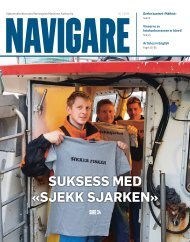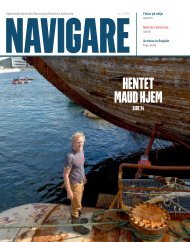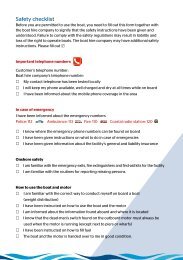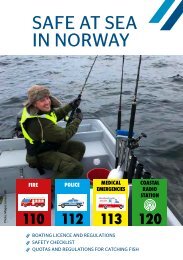Navigare 3 - 2019
Create successful ePaper yourself
Turn your PDF publications into a flip-book with our unique Google optimized e-Paper software.
news<br />
SAND FREIGHT: The cargo ship Mercator is owned by Stabben Shipping AS in Os, Hordaland, and the<br />
vessel was unloading sand in Drammen when the accident occurred. On its way through Karmsundet.<br />
PHOTO: BJARTE AMBLE<br />
risk of accidents posed by the skid-steer<br />
loader.<br />
The skid-steer loader was used to collect the<br />
rest of the sand in the cargo hold to make it<br />
easier for the vessel›s excavator to lift the cargo<br />
ashore. Both machines belonged to the vessel<br />
and were operated by crew members.<br />
COURSE OF EVENTS<br />
Mercator arrived in Drammen the night before<br />
the accident, and the able seaman who normally<br />
operated the skid-steer loader was informed that<br />
a bolt in the bucket›s lift arm had come loose. It<br />
was decided that the loader had to be repaired.<br />
The able seaman inserted the new safety<br />
bolt and repaired the loader›s bucket before the<br />
loader was put into use that morning. After two<br />
to three hours in operation in the cargo hold,<br />
however, the bolt came loose again. The able<br />
seaman asked the chief engineer officer to fetch<br />
a hammer. As the chief engineer officer was<br />
returning, he saw from the main deck that the<br />
able seaman was working on the skid-steer<br />
loader in the cargo hold. But as the chief<br />
engineer officer entered the cargo hold, he<br />
found the able seaman severely injured between<br />
the bucket and the operator›s compartment. He<br />
was alive but could barely speak. He was just<br />
pointing to his chest. The skid-steer loader›s<br />
engine was running.<br />
The Emergency Medical Communication<br />
Centre (EMCC) was notified immediately, and<br />
the able seaman was given emergency medical<br />
care before taken to hospital. A few hours later<br />
he was pronounced dead. The post-mortem<br />
report concluded that death was due to crush<br />
injuries.<br />
SAFETY FEATURES<br />
The skid-steer loader had several safety features<br />
to prevent accidents. According to the user<br />
manual, the loader was equipped with a<br />
mechanical parking brake to prevent propulsion<br />
when the engine was running. During a repair<br />
of the lift arms or bucket, a support for the lift<br />
arms must be used.<br />
The loader also had a restraint bar to<br />
prevent the use (by pedals) of lift arms and<br />
bucket with no driver in the seat. The loader<br />
should also have a sensor in the seat (seat<br />
switch) which stops the engine when the driver<br />
leaves the seat.<br />
All of these safety features are requirements<br />
which the manufacturer must comply with in<br />
order to obtain a CE marking for the loader<br />
and thus be able to sell it on the European<br />
market. Even if the machine was used on board<br />
a vessel that is subject to other legislation, the<br />
loader must comply with the above-mentioned<br />
safety requirements.<br />
PROBABLE CAUSE<br />
The analysis from the AIBN points to the fact<br />
that none of the other crew members were<br />
present when the able seaman installed the new<br />
safety bolt in the morning, even though this was<br />
a type of repair work that had not been<br />
performed on board before. No risk<br />
assessment had been done before the work<br />
started, and there was nobody on board to<br />
evaluate the potential high risk of the repair<br />
work. This was due to a lack of knowledge<br />
of the skid-steer loader›s safety features as<br />
well as a lack of knowledge about potential<br />
risks that might arise during the work.<br />
The AIBN cannot explain why another<br />
problem arised with the safety bolt, but the<br />
board implies that the bolt might have<br />
slipped out because it was not properly<br />
installed the first time.<br />
The board cannot conclude with any<br />
degree of certainty what went wrong during<br />
the second repair, but it is probable that the<br />
able seaman was standing between the<br />
bucket and the operator›s compartment to<br />
hit the bolt while the engine was running.<br />
The able seaman probably tried to move the<br />
loader›s lift arms by leaning into the<br />
operator›s compartment to adjust the pedals<br />
by hand. He was then able to hit the bolt<br />
into place with the other hand when the bolt<br />
holes were aligned. The skid-steer loader is<br />
equipped with pedals having quite sensitive<br />
control functions. Most likely, the able<br />
seaman pressed the pedal too hard, causing<br />
the bucket to tilt back in an uncontrolled<br />
manner towards the operator›s compartment,<br />
crushing the able seaman. The able seaman<br />
managed to get loose, most likely by steering<br />
the bucket forward again.<br />
LACK OF CONFORMITY<br />
The skid-steer loader was a Mustang 2044<br />
and a 2005 model. It was included in the<br />
sale when Stabben Shipping AS bought the<br />
ship in May 2018 from Sama Shipping &<br />
Management AS. The captain informed that<br />
he was not aware of any problems with the<br />
loader.<br />
The loader was investigated by a<br />
technical company after the accident. The<br />
AIBN and the police were present. There<br />
was no service history. The investigation<br />
reported that the loader did not have a user<br />
manual, and there was no documentation of<br />
any completed periodic surveys. A number<br />
<strong>Navigare</strong> 3 - <strong>2019</strong> | 57


